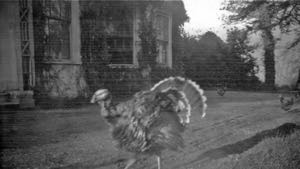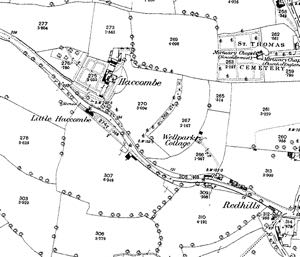
Haccombe House, Redhills
Researched and written by Julia Sharp
Page added 22nd October 2014
Devon used to have two gentry houses named Haccombe. The larger is Haccombe with Coombe near Newton Abbott and the other, Haccombe, Redhills in St. Thomas Exeter.
Haccombe with Coombe belonged to the Carew family and has now been converted into a number of flats. Whereas Haccombe Redhills has suffered the fate of so many gentry houses in the Country, especially where they are situated near a large city such as Exeter; demolition and conversion into housing estates.
At present, the date when Haccombe Redhills was built is not known, however it does not show on the first Ordnance Survey drawing that was surveyed in 1801 but is included in Hayman’s map of 1806. It has been described as a typical Regency Villa.
Redhills was on the road to Okehampton, just after the Toll Gate, which was situated on the junction of Okehampton Road, Exwick Road and Buddle Lane. The hill was very steep at this point causing problems for those living there.
Described in an advert
In 1810 there was an advert offering the house for letting, which states it ‘is one mile from the city’. In December 1836, William Lee of Haccombe House died, and immediately after, in 1837, the House was for Sale, offering ‘the Remainder of an absolute Term of 40 years, 38 of which were unexpired at Michaelmas last, under the yearly conventionary Rent of £15’:
After extolling the virtue of the position: in a dry situation, on an eminence, with Lawn in front, commanding magnificent views of the City and surrounding Country on both sides of the River Exe, from Exeter to Exmouth, Powderham with the Woodbury Hills etc.etc.
It noted that the House consists of Breakfast Parlour 11.9 X 9.5
Dining Room 22.0 X 14.0
Drawing Room 14.0 X 20.0
8 Bedrooms, 2 dressing Rooms,
Water closet, Kitchen
Underground & other cellars
All necessary domestic offices
3 stall stables & Double coach house
2 Walled Gardens; Large Kitchen Garden
About 10 acres of rich pasture land
Well supplied with good water
Forming a comfortable, healthy, and desirous Residence for a genteel Family
An occupier was William Kingdon who, with his brother Samuel (Iron Sam) Kingdon, co-owners of Garton & King, a large firm of Ironmongers in Exeter. William was a bachelor, and was living at Haccombe when the brothers retired from their business in 1849. He did not have too long to enjoy his retirement however as he died on 14 January 1858.
Richard Wake was living at the property in 1864 when he was taken to court by William Westlake a dairyman of King Street Exeter. Mr. Westlake complained he had been in the employ of Mr. Wake and had been discharged without any notice.
He sued for 10s. paid for pheasants’ and partridges’ eggs and £2 for wages. Apparently Mr. Wake liked to shoot his own birds.
In his defence Mr. Wake said he had some valuable vines and had given Mr. Westlake express orders not to interfere with the vines. He disobeyed this order and Mr. Wake dismissed him. In evidence Mr. Wake said that finding that Mr. Westlake was ignorant as to their treatment, he gave him directions not to cut them. He had, however, done so and injured them to the extent of £12 or £15. His wages had been paid up to the time of his departure, and a fortnight over. Mr. Westlake said he had great experience in pruning vines, and was willing for any gardener to check as to whether the vines were injured. He also denied that Mr. Wake told him not to touch the vines. The judge found in favour of the defendant, Mr. Wake.
Once again the length of stay at Haccombe for the residents was not very long. August 1868 saw an advert in the paper offering the House for Sale with immediate possession, together with Grounds, Plantations and Gardens and two Fields of capital Pasture, about 7 acres, making about 9 acres in total. Possibly it did not prove easy to find a genteel family to take on the property. In 1870, the Probate Court ruled that an Administrator be appointed for the will of Richard Wake, with his wife entering a caveat. It was noted the estate was in the region of £35,000. Around the same time the contents of Haccombe was auctioned in 190 lots, and the Residence ‘Haccombe with a walled garden and about 14 acres’ was up to Let for the remainder of a term. Once again the amount of land offered differed from that in previous advertisements.
The next known residents of Haccombe moved in sometime in the 1870s. Rev. James Richard Whyte was the Vicar of Launcells Cornwall, a hamlet within three miles of Bude, for many years. In 1870 his wife, Louisa Lucy died leaving him a widower at age of 62. In the 1871 census he had two nieces living at the Vicarage, as well as 3 servants. When he left Launcells is not known but in 1874 he married Janet Bogle whose family had associations with Exeter.
The house is burgled
During the 1870’s they must have moved to Haccombe, as there is a report of ‘Housebreaking in St. Thomas’ in the Newspapers in February 1879. Charles Coleman, a respectably-dressed young fellow, described as a labourer of Duke’s Place, Fore Street Exeter came before the Magistrates on charge of breaking into Haccombe House and stealing a Shawl, plated forks and spoons, 2 pairs of boots, a brush, and other articles. Jane Mole, the Cook at Haccombe remembered that when the household had retired to rest, the premises were secured and, as usual, the kitchen window which looked out into a yard, was left a little open for the cats to go in and out. Next morning, she found the kitchen turned upside down and several articles missing including, in the dairy, a pound and a half of butter and some milk which had been drunk. PC Vanstone made enquiries and found a number of the missing articles in possession of persons who had bought them from men to whom they had been handed to sell by the prisoner. The prisoner said he had bought the articles from a man in the Ship Inn, Alphington Street, St. Thomas, but enquiries at the Inn found that no such person as the prisoner described had ever been there.
At the Assizes, the Prisoner was found guilty. The Judge remarked it was fortunate that the prisoner had not resorted to violence, if he had he would have been sent to penal servitude. As it was he would have a lenient sentence – six months hard labour. Rev. Whyte died on 30 May 1880, at the house. Janet Whyte continued to live at Haccombe until her death on 5 November 1933 at the age of 94. It is probable that during her widowhood of over 50 years, her income had not kept up with the cost of repairs and more generally. The house was said to be in a poor state of repair. In 1934 the contents were auctioned, with the property being advertised for Sale in 1937 and 1938. It was for sale with 11¾ acres which had planning permission for 138 houses which were Town Planned 12 to the acre.
The last years
The property was bought by a developer in the semi-derelict state. His family lived in London and when WW2 started he offered the house to his extended family as a safer place to live than London. The House still had a Regency feel about it, but was in a very bad state of repair with a leaking roof. The family had to live in the downstairs rooms. The gardens including the kitchen garden and an orchard were still there. They used a horse and cart, and the women had to walk beside the horse on the way up Redhill as it was so steep.
The children of the family remembered seeing the bombs fall on Exeter and seeing it in flames. They have very happy memories of their time there. After the War the family left and the property was sold again. Now the land forms Addison Close and Ashleigh Mount Road.
Sources: Western Times, Exeter and Plymouth Gazette and a post on the forum by user mikekan.
 The only known photo of Haccombe House. Taken in the 1940s, when the house was occupied by a family from London, it shows a small part of the front facing Exeter, and of course, a turkey! Photo Mike Kan.
The only known photo of Haccombe House. Taken in the 1940s, when the house was occupied by a family from London, it shows a small part of the front facing Exeter, and of course, a turkey! Photo Mike Kan. This map shows precisely the position of Haccombe House. I have not been able to source a photo of the house.
This map shows precisely the position of Haccombe House. I have not been able to source a photo of the house.
│ Top of Page │